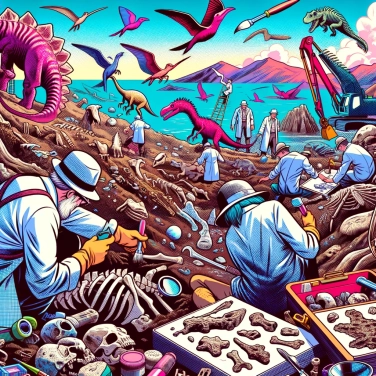In detail, for those interested!
Favorable paleoenvironment
Regions of the globe rich in fossils often have a paleoenvironment favorable to life and the preservation of organic remains. These conducive environments have allowed for the fossilization of ancient organisms and have therefore contributed to the paleontological richness of these regions.
A favorable paleoenvironment can be characterized by stable and mild climatic conditions, conducive to significant biological diversity. Moderate temperatures, regular precipitation, and an abundance of food resources have created prosperous ecosystems where many organisms have been able to thrive.
The presence of varied habitats such as dense forests, swamps, lagoons, or coral reefs has also contributed to species diversity and fossil preservation. These environments offered different ecological niches, allowing many forms of life to coexist and develop.
Furthermore, the geology of these regions may have played a crucial role in fossil preservation. The presence of sedimentary rocks rich in minerals has favored the fossilization of organisms, ensuring their burial and conservation over long periods of time. Processes such as diagenesis have allowed the transformation of organic remains into fossils.
In summary, regions of the globe rich in fossils are distinguished by a paleoenvironment favorable to life and the preservation of organic remains. The climatic conditions, habitat diversity, and geology of these regions have contributed to the paleontological richness that we observe today.
Ideal preservation conditions
The ideal preservation conditions of fossils depend on several key factors. The speed of burial of organic remains is a crucial element for their conservation. Indeed, the faster organisms are covered by sediments, the less they are exposed to decomposition and destruction by external agents.
The nature of sediments also plays an important role in fossil preservation. Fine and impermeable sediments are more conducive to the conservation of organic remains, as they limit the circulation of water and chemicals that could damage the fossils.
Plate tectonics can also influence the conditions of fossil preservation. Tectonic movements can lead to the formation of sedimentary basins where deposits accumulate slowly, thus favoring the fossilization of organisms.
Furthermore, the presence of anoxic conditions, meaning a lack of oxygen, in depositional environments can also contribute to fossil preservation by limiting the activity of decomposing bacteria.
Finally, phenomena such as mineral impregnation, where the tissues of organisms are replaced by minerals, can play an important role in preserving the anatomical details of fossils. These complex processes are essential for understanding why certain regions of the globe are so rich in well-preserved fossils.
Tectonic and sedimentary activities.
Tectonic and sedimentary activities can play a crucial role in the preservation of fossils. Tectonic movements, such as folding, faults, and uplifts, can expose geological layers that were once buried underground, making it easier to discover fossils. These movements can also create conditions conducive to fossilization by allowing the formation of new habitats and promoting the preservation of organic remains.
On the other hand, sedimentary processes are essential for fossilization. Sediments such as mud, sand, and clay can quickly cover organism remains, protecting them from decomposition and damage caused by external elements. Over time, these sediments can compact to form sedimentary rocks, enclosing the fossils inside and preserving them for millions of years.
Furthermore, marine sedimentary environments, such as seabeds and deltas, are particularly rich in fossils due to the constant accumulation of sediments and the diversity of organisms that live there. These environments offer ideal conditions for the preservation of organism remains, leading to the formation of important fossil deposits worldwide.
Past biological diversity
In the past eras, Earth housed an incredible biological diversity. Fossils give us a fascinating glimpse of this ancient life. Trilobites, extinct marine creatures, are among the most common fossils. Dinosaurs, fearsome extinct reptiles, are also stars of fossil collections. Fossilized plants, such as giant tree ferns, provide insights into ancient ecosystems. Mammoths and mastodons, extinct members of the elephant family, are among the largest fossil mammals. Ammonites, spiral-shaped marine mollusks, are also spectacular fossils. These different fossils testify to the incredible diversity of past life on our planet.
![Explain why some countries change time zones?]()
![Explain why Alexander the Great refused to wear shoes.]()
![Explain why Alexander the Great always wore an impressive helmet.]()
![Explain why the last Chinese emperor was so young when he came to power?]()





















